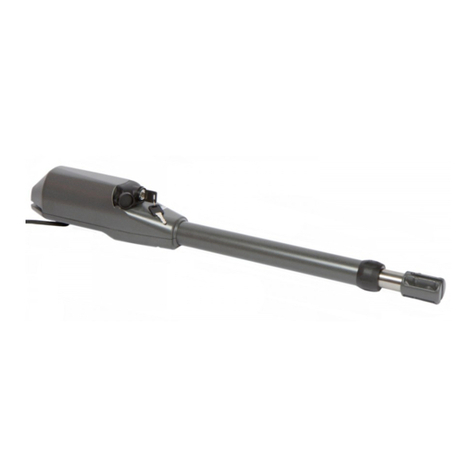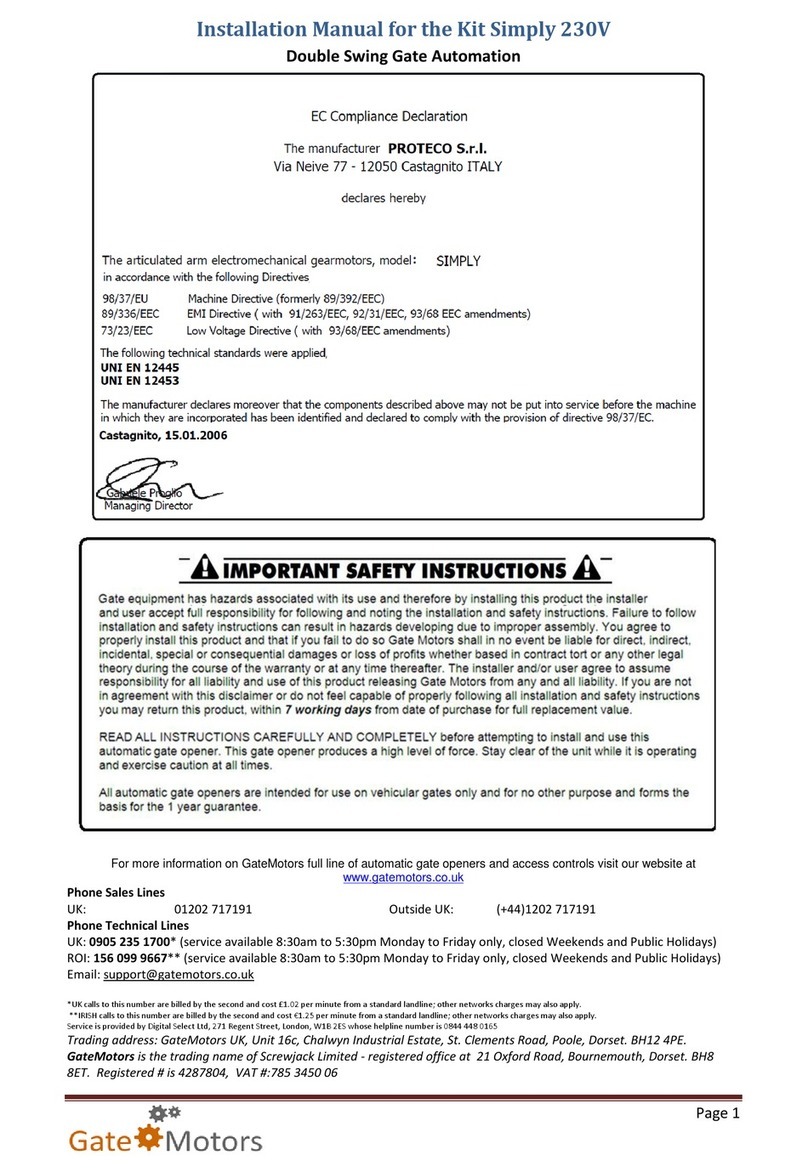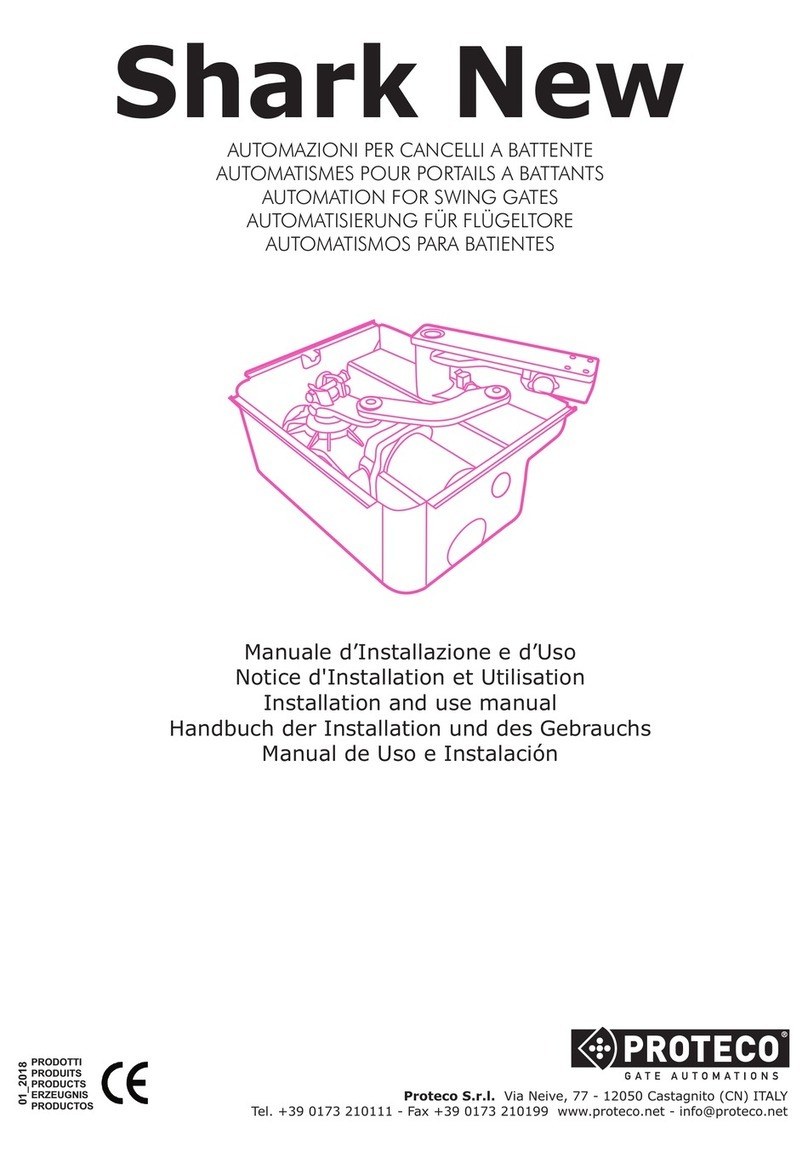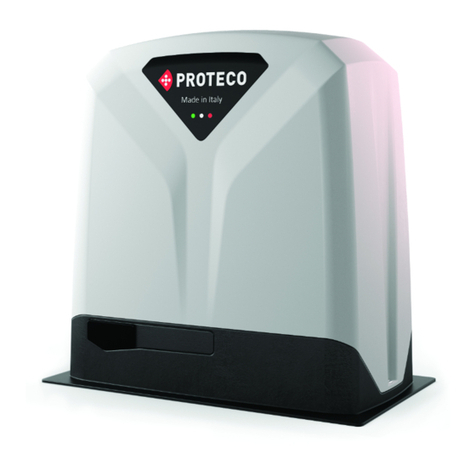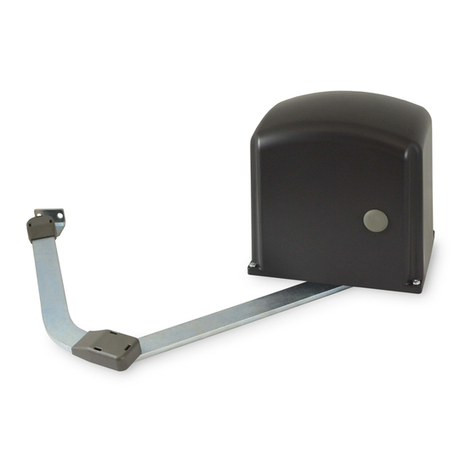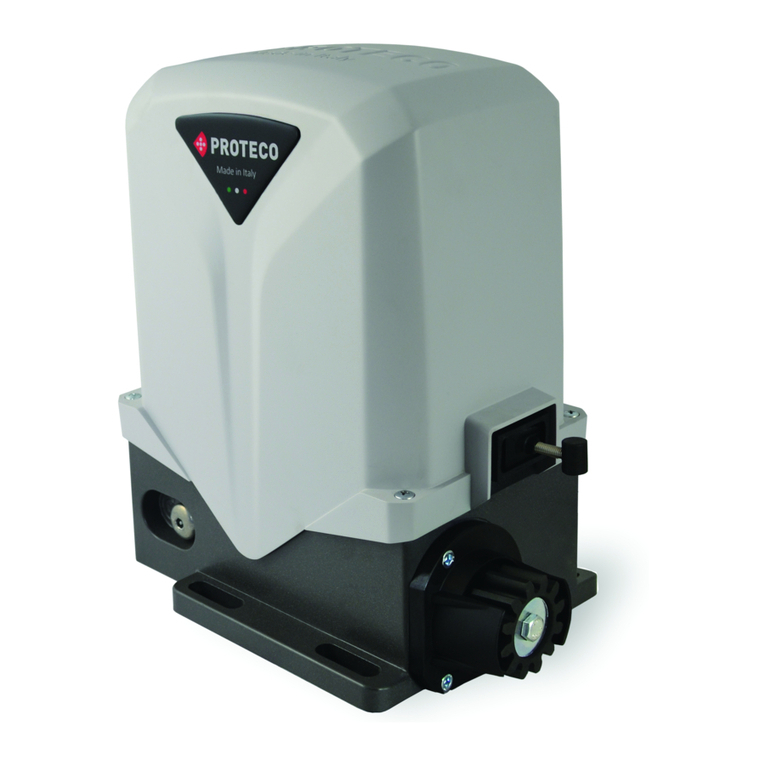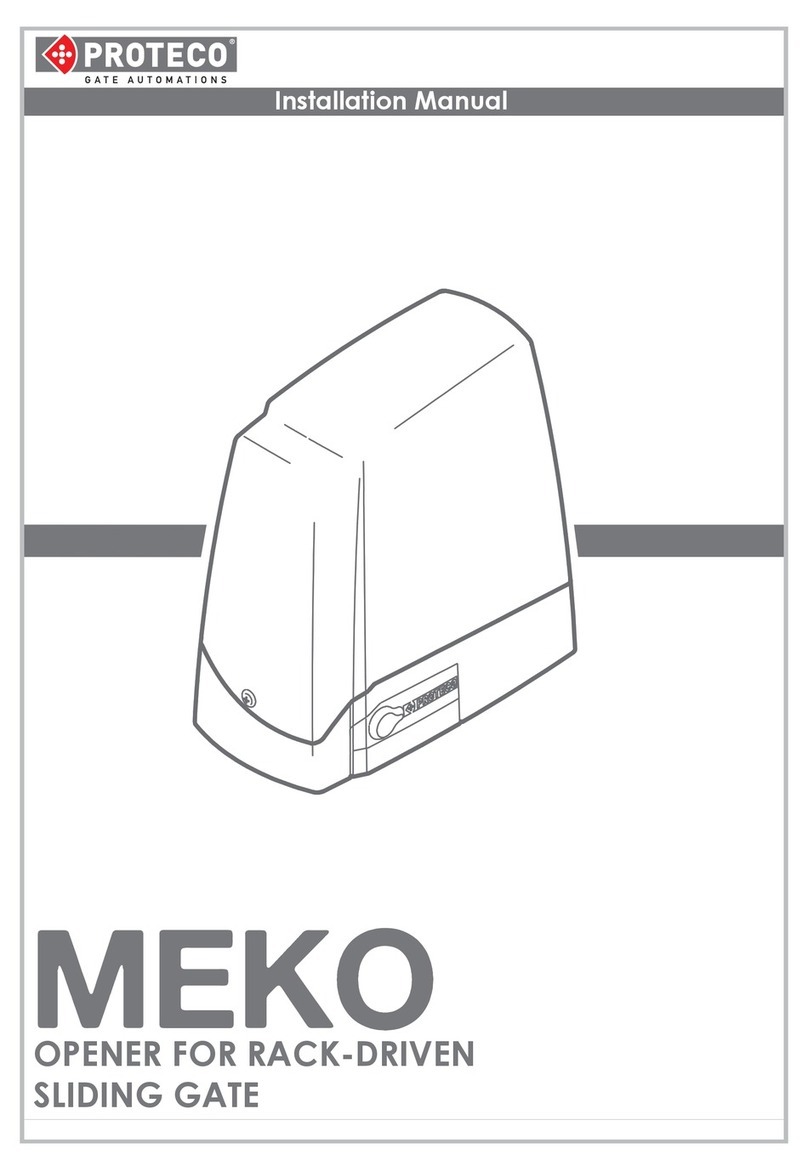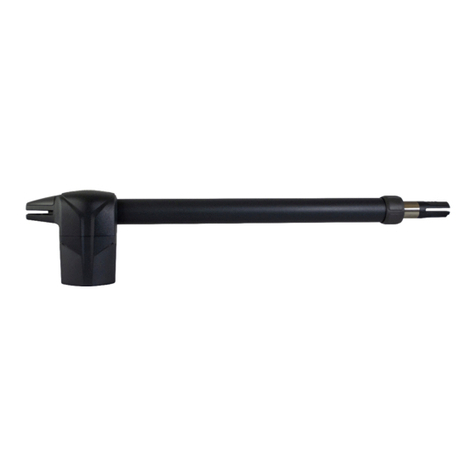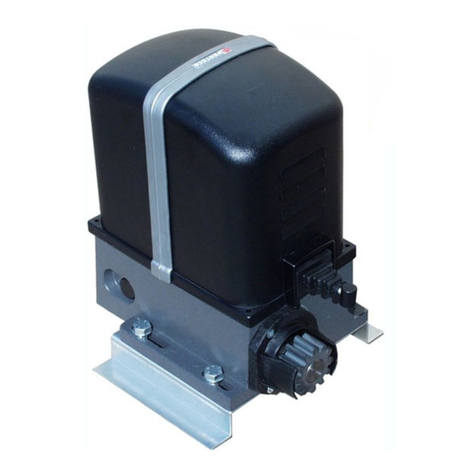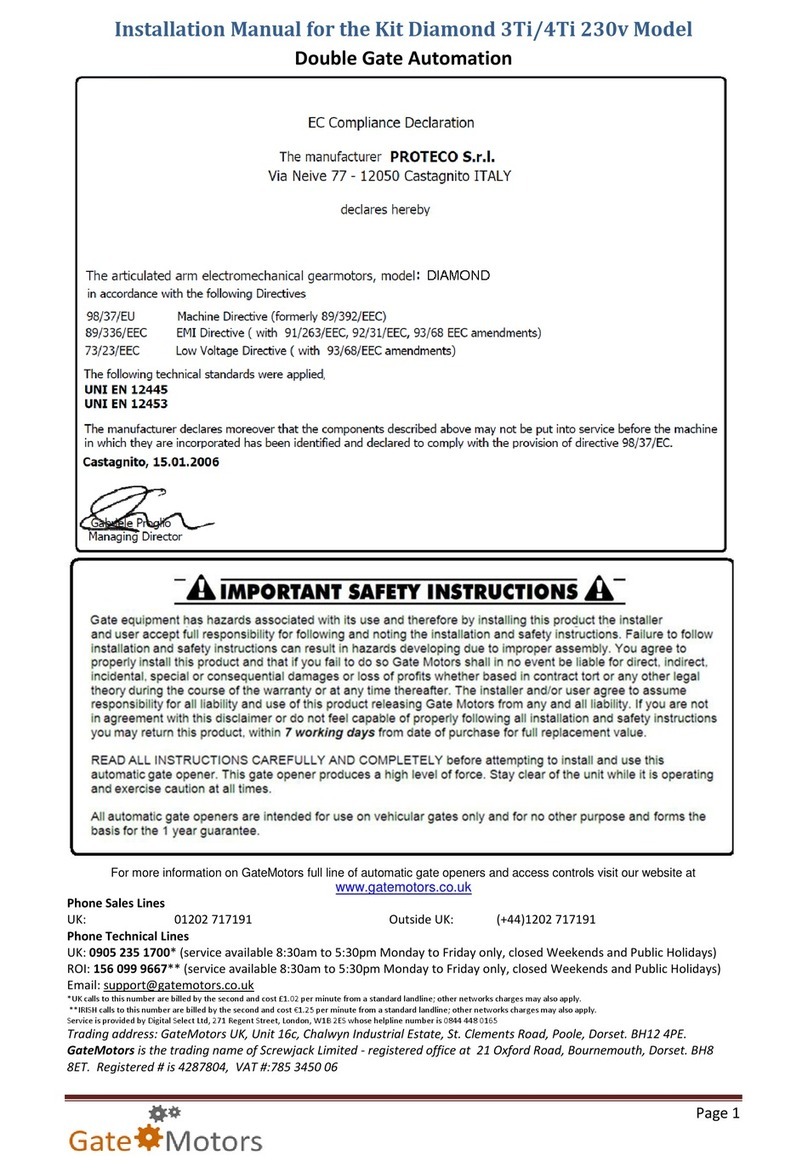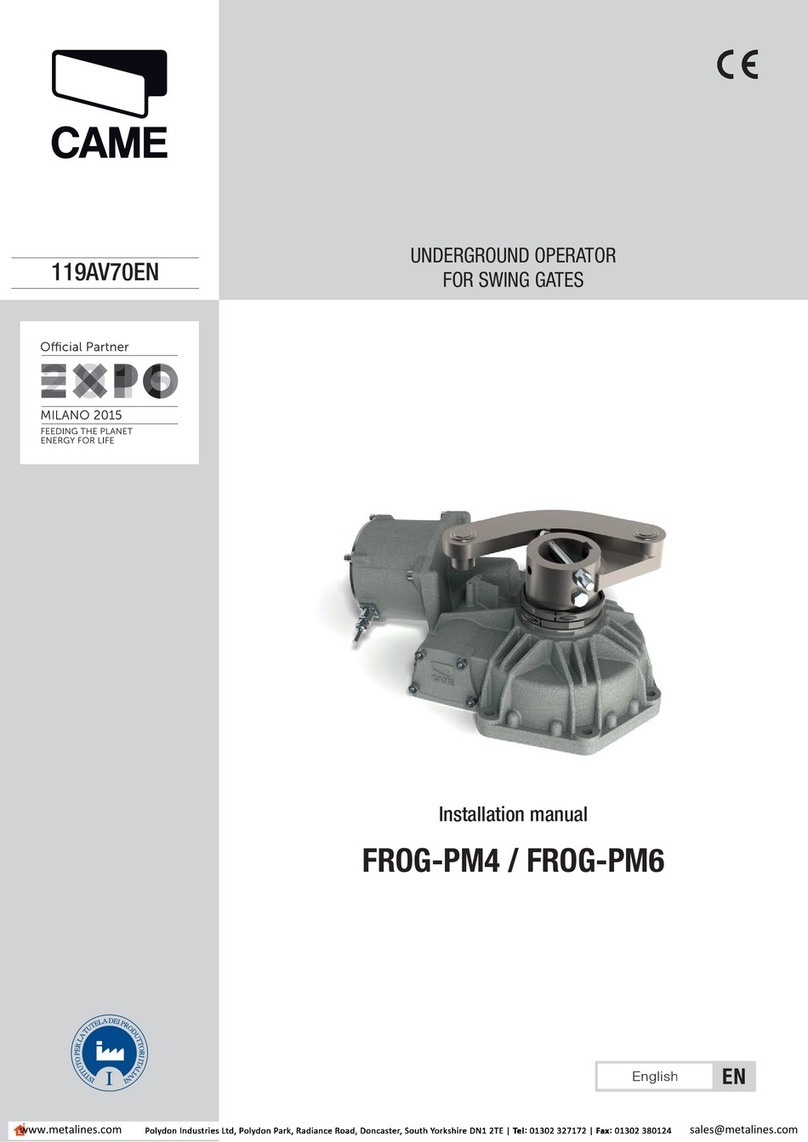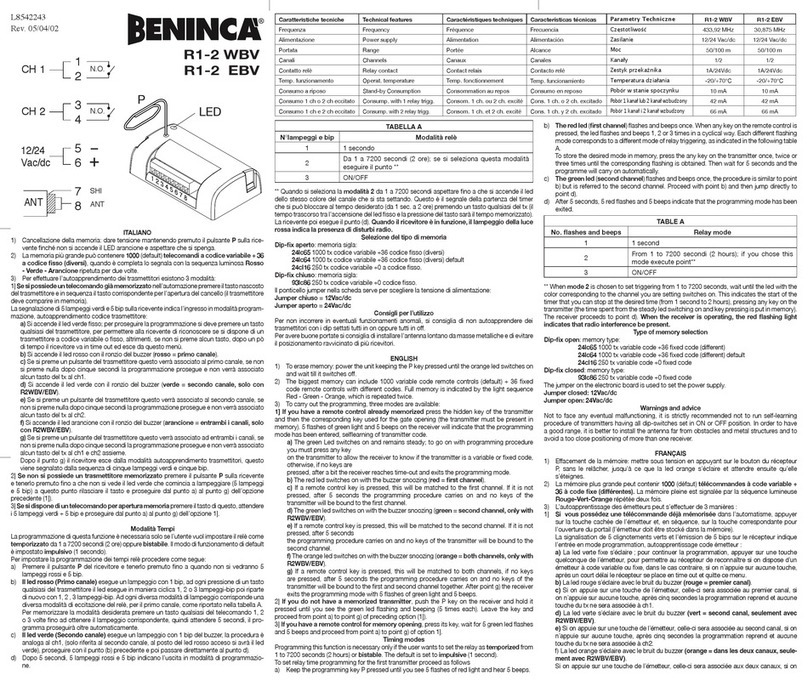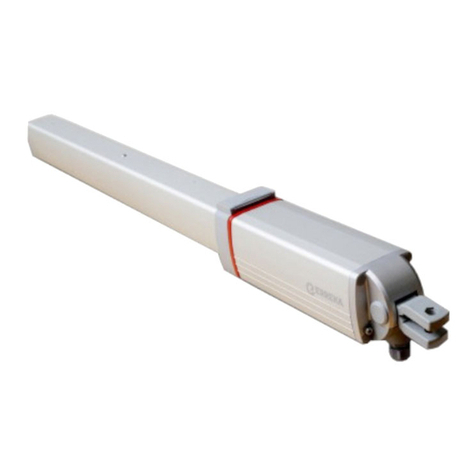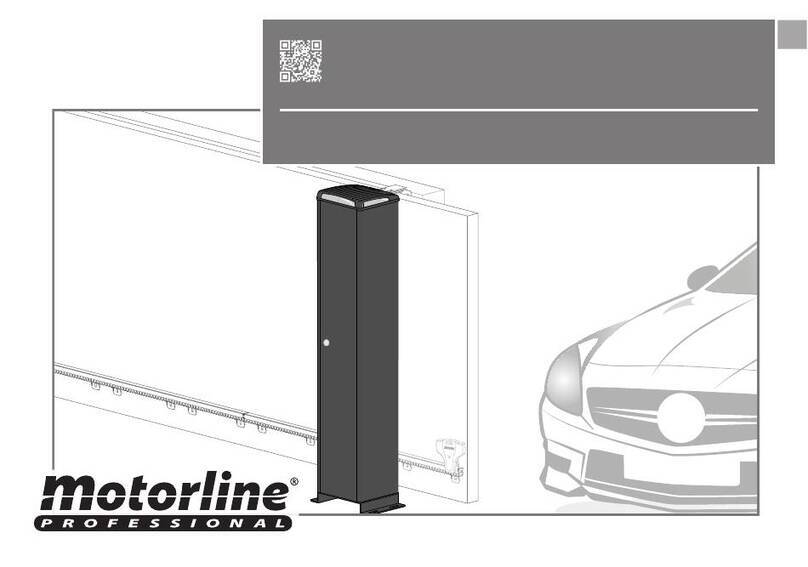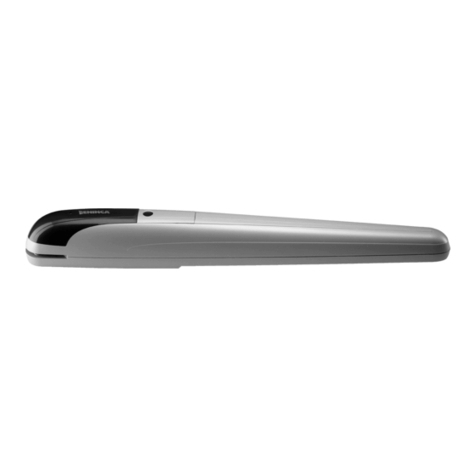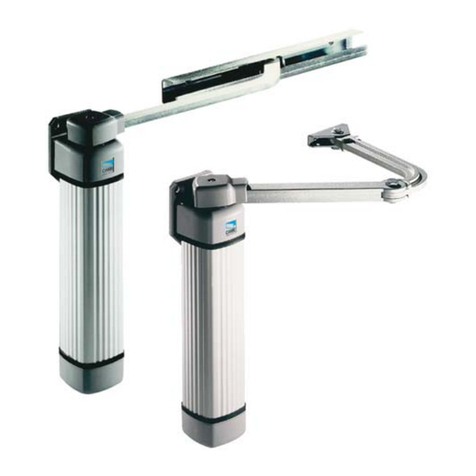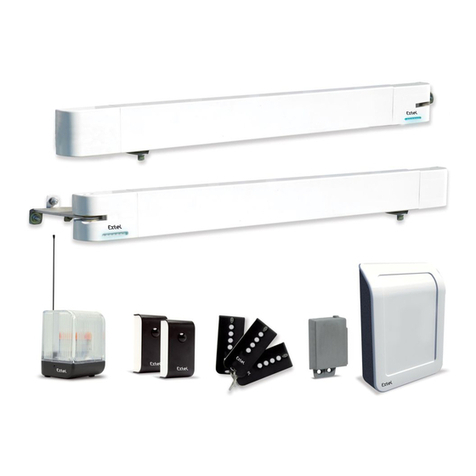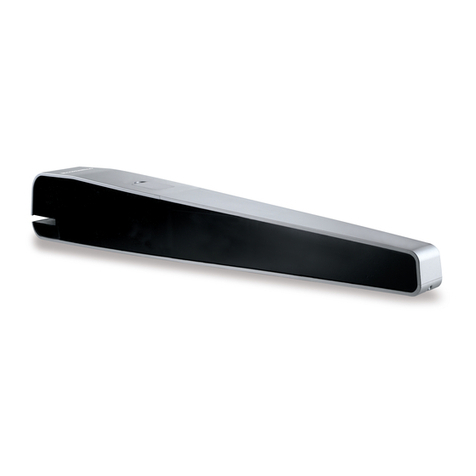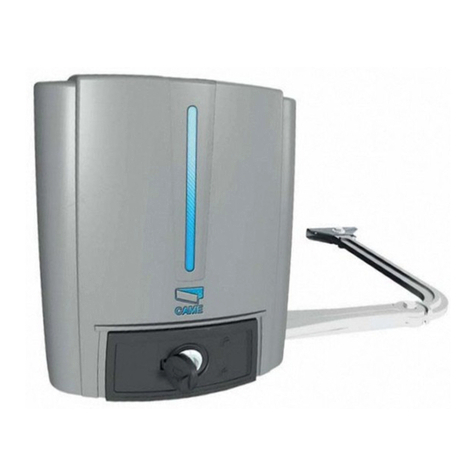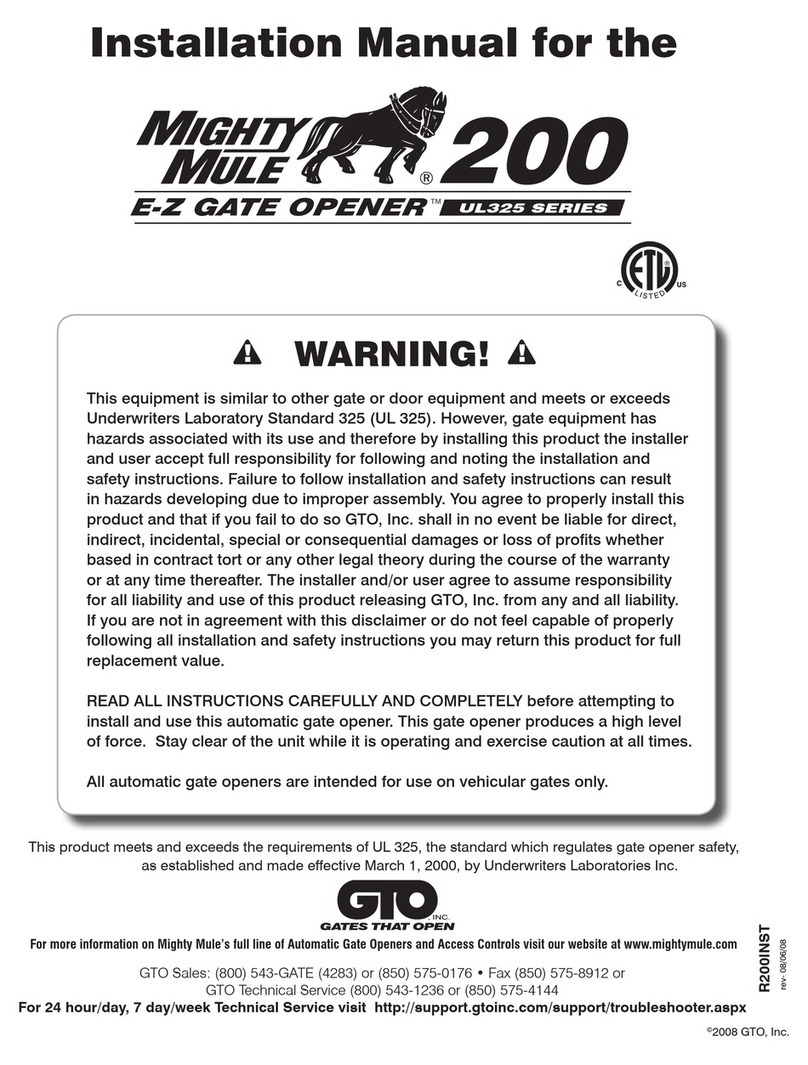
POLSKI
KRYTERIA BEZPIECZEŃSTWA
1 Uwaga:przedrozpoczęciempracyprzyurządzeniunależyzapoznaćsięzcałą
Instrukcją.
2 Wykonać testy sprawdzające, czy parametry siłownika odpowiadają potrze-
bomnabywcy.
3 Sprawdzić,czy:
-Zawiasybramysąwdobrymstanieiprawidłowozamocowane.
-Bramaposiadamechaniczneogranicznikiruchuwpozycjiotwarciaizatrzy-
mania.
ZALECENIA DOTYCZĄCE INSTALACJI
Połączenia:
• Patrz„Schematdziałania”izapoznajsięzeschematemcentralisterowniczej.
• Przewódelektrycznywychodzącyzsiłownikaniepowinienbyćnaprężony,ale
szerokozagiętykudołowiabyuniknąćszarpnięciasiłownika.(Rys.O)
• Regulacjęnależywykonywaćprzywyłączonymzasilaniuurządzenia.
• Należy przewidzieć wyłącznik wielobiegunowy blisko urządzenia (minimalny
wymiar styku: 3mm). Zawsze zabezpieczać zasilacz wyłącznikiem automa-
tycznym6Alubjednofazowymwyłącznikiem16Azbezpiecznikami.
• Przewodyzasilająceprowadzącedosilnikówijednostkisterującejorazprze-
wodyłączącezelementamiwyposażeniadodatkowegopowinnybyćoddzielo-
ne,abyuniknąćewentualnychzakłóceńwpracyinstalacji.
• Przypodłączaniudojednostkisterującejwszystkieurządzeniadodatkowe(za-
równosterujące,jakizabezpieczające)powinnybyćodłączoneodzasilania.
Części zamienne:
• Stosowaćwyłącznieoryginalneczęścizamienne.
• Akumulatoryusuwaćwrazzodpadamiprzemysłowymi(Ust.nr475/88).
Instalacja:
• W celu zapewnienia prawidłowej eksploatacji urządzenia i wyeliminowania
możliwościpowstaniaobrażeńlubuszkodzeńnależyzapoznaćsięztreścią
strony„Instrukcjeogólne”stanowiącejintegralnączęśćniniejszejInstrukcji.
• Użytkowaniesprzętupowinnobyćzgodnezprzepisamibezpieczeństwaobowią-
zującymiwkrajuużytkownikaoraznormamidotyczącymiprawidłowejinstalacji.
Gwarancja:
• Gwarancjaudzielonaprzezproducentaulegaunieważnieniuwnastępujących
przypadkach:manipulowania urządzeniem,niedbałości, nieprawidłowejeks-
ploatacji,uszkodzeńspowodowanychprzezwyładowaniaatmosferyczne,sko-
kównapięcialubużytkowaniaprzezniewykwalikowanypersonel.
• Gwarancjatracirównieżważnośćwsytuacjinieprzestrzeganiazaleceńzawar-
tychwInstrukcjachdołączonychdourządzenia,stosowaniaczęściwsposób
niezgodnyzaktualnieobowiązującymiprzepisami,alboużywaniaczęściza-
miennych,któresąnieodpowiednielubnieposiadająaprobatyproducenta.
• Producent nie ponosi odpowiedzialności za uszkodzenia powstałe wskutek
nieprawidłowegoiniewłaściwegoużytkowaniaurządzenia.
PROCEDURA POSTĘPOWANIA PRZY INSTALACJI
1 Przedrozpoczęcieminstalacjinależyprzeanalizowaćzagrożeniaodnoszącsię
dorozdziału„Instrukcje ogólne”,stanowiącegoczęśćniniejszejInstrukcji,wy-
pełnićtabelętechnicznąiwyeliminowaćwystępująceproblemy.Wprzypadku
braku możliwości usunięcia wszystkich zagrożeń, należy przewidzieć odpo-
wiedniesystemyzabezpieczająceinstalację.
2 Sprawdzićzasadydotyczącebezpieczeństwaopisanewczęści„Kryteriabez-
pieczeństwa”.
3 Zidentykowaćprawyilewysiłownik.
4 Sprawdzićwszystkieelementy.
5 Znaleźćpunktymocowanianabramie,anastępnienasłupku.
6 Sprawdzićwymiar„D”.
7 Dopasowaćwsporniki S1 iS2 zgodniez„Tabelą 1”.
8 Zamocowaćsiłownikdowsporników S1 iS2.
9 Zwolnićsiłownik.
10 Przymocowaćwspornik S3 dobramy.
11 Osadzićobudowętłokanawsporniku S3.
12 Poprowadzićkablejakna„Schemacie działania”.
13 Podłączyćjednostkęsterującąiwszystkieurządzeniadodatkowe.
14 Zaprogramowaćodbiornikradiowy.
15 Zaprogramowaćczasypracy.
W przypadku nieprawidłowego funkcjonowania urządzenia należy zapoznać się
zczęścią„Nieprawidłowości i zalecenia”.
Jeżeli żadne rozwiązanie nie zostanie znalezione, należy skontaktować się
znajbliższymCentrumObsługi.
ZABLOKOWANY SIŁOWNIK
Siłownikiwurządzeniachmyaster 3/4/5mogązostaćzablokowane.
Należy zwrócić uwagę, że blokada elektryczna powinna być zainstalowana na
skrzydleotwierającymsięjakopierwszeipodłączonadopłytyzaciskowejjednostki
sterującej.Pozycjablokadyelektrycznej:(Rys.N):
Pozycja 1:Blokadamiędzyskrzydłami
(wtymprzypadkunależyzastosowaćśrubęRT15nadrugimskrzydle).
Pozycja 2:Blokadanapodłożu(wtymprzypadkuużycieśrubyniejestkonieczne).
Należypamiętaćousunięciublokadylubzablokowaniubramywpozycjiotwartej
iwyjęciuwszystkichśrub.
Prawyilewysiłownik(Rys.D)
Siłownikisądostarczanewwersjiprawejilewej.
Prawąlublewąwersjęokreślasiępatrzącnabramęodstrony,gdziezainstalowane
sąsiłowniki-jeżelizawiasysąpoprawejstronie,siłownikjestprawy,jeżelipolewej,
siłownikjestlewy.
WYZNACZANIE PUNKTÓW MOCOWANIA
Brama zamocowana w środku słupka (Rys.A)
Wtymprzypadkumaksymalnykątotwarciabramywynosi90°.
-Umieszczeniewspornikówmocującychwpunktachwskazanychwtabelinad
rysunkamiAiBzapewniaprawidłowefunkcjonowanieurządzenia.
Wprzypadkuwystąpieniatrudnościpodczasinstalacjinależypostąpićwnastępu-
jącysposób:
-Zmierzyćpoziom D(odległośćmiędzyosiązawiasówakrawędziąsłupka)
-W tabeli 1,wczęścidotyczącejzakupionegonapęduznaleźćodpowiadającą
muliniępoziomu D.
-Wponiższejtabelimożnaznaleźćniezbędne wskazówkiiustalić,czylepiej
jestużyćwspornika S1 (Rys.E),czyalternatywniewspornika S2 (Rys.F).
Wartościsąobliczanedlauzyskaniaśredniejprędkościstycznejnieprzekraczają-
cej12m/min.
Brama zamocowana na krawędzi słupka (Rys.B)
Wtymprzypadkubramamożesięotwieraćpodkątemwiększymniż90° (maks.120°).
-Umieszczeniewspornikówmocującychwpunktachwskazanychwtabelinad
rysunkamiAiBzapewniaprawidłowefunkcjonowanieurządzeniaprzykącie
otwarcia90°.
-Abyskrzydłootwierałosiępodwiększymkątem,wymiarApowinienbyćwięk-
szyniżwymiarB.
NajlepszymrozwiązaniemjestzwiększeniewymiaruAotąsamąwartość,ojaką
należyzmniejszyćwymiarB.
WYSOKOŚĆ MONTAŻU
Wyznaczyćwysokośćmontażusiłownikawzależnościodkształtubramyimożli-
wościmocowania.(Rys.G)
a) Jeżelibramamamocnąkonstrukcję,siłownikmożnaumieścićnadowol-
nejwysokościbezżadnychograniczeń.
b) Jeżelikonstrukcjabramyjestlekka,siłowniknależyzainstalowaćmożliwie
jaknajbliżejśrodka(wysokości)bramy.
Pozycja 1:Centralnabelkabramy
Pozycja 2:Wzmocnienie bramy; odległość między podstawą kołnierza siłownika
apodłożempowinnaprzekraczać10÷15cm.
MOCOWANIE WSPORNIKÓW
Wsporniki S1 i S2 należy przymocować śrubami lub przyspawać do bocznego
słupkabramy,pamiętającżewymiary A iB odnosząsiędoosizawiasówbramy
orazdoosiobrotusiłownika.
Wprzypadkumocowaniaprzypomocyśrubrozporowych,należyzastosowaćśru-
by metalowe ø 13mm, umieszczając śrubę co najmniej 30÷35 mm od krawędzi
słupka,abyuniknąćjegopęknięcia.(Rys.H)
Wprzypadkusłupkówmurowanychnależyposłużyćsięchemicznąmetodąmoco-
wania,śrubąklejową,alboużyćwspornikacementowanego.
-Wspornik S1 (Rys. E) występuje w dwóch wersjach: wspornik S1 prawy
iwspornik S1 lewy;należyjezastosowaćdoodpowiedniegosiłownika.
-Zamocowaćsiłownikdowspornika S1 jakpokazanona„Rys.I”pamiętając,
żegwintowanyotwórtrzpieniaobrotowegoPR1 powinienbyćobróconywdół.
WSPORNIKI S2 (Rys.F)
Wniektórychprzypadkach,jakpokazanowTabeli 1 orazprzyinstalacjachspecjal-
nych,lepiejjeststosowaćwsporniki S2.
Każdywspornikposiadajednąkwadratowąpłytkęowymiarach130x130x6mmz4
otworamiø12mmorazwspornikowymiarach112x94x55mmz3otworamiø2mm.
Instrukcja montażu:
Przymocowaćpłytkędosłupkaprzypomocymocnychkołków.
-PrzyspawaćwspornikdopłytkijakpokazanonaRys.F.
-Należypamiętać,żewymiary A iB odnosząsiędoosizawiasówbramyiosi
obrotunapędu.
MOCOWANIE PRZEDNIEGO WSPORNIKA
Ustalićpozycjęwspornika S3 wnastępującysposób:
-Zamknąćskrzydłobramy.
-Zwolnićmotoreduktor.
-Elementze staliinoxpowinienobrócićsięcałkowicieażdomechanicznego
zatrzymania(skokmaksymalny).
-Cofnąćrurkęzestalinierdzewnejookoło2cm.
-Przymocowaćwspornik S3 dosiłownikazapomocąsworzniaPR1 (Rys.L).
(notabene:dolnaczęść)
-Oprzećwspornik S3 naskrzydleutrzymującsiłownikidealniepoziomo(naj-
lepiejposłużyćsiępoziomnicalkoholową)iprzymocowaćwspornikśrubąlub
przyspawać.
(nota bene: Sprawdzić ręczne otwieranie skrzydła przed ostatecznym zamocowa-
niem wsporników i upewnić się, że skrzydło otwiera się do końca.
MECHANICZNY OGRANICZNIK RUCHU (Rys.D)
W tym momencie należy ustawić ogranicznik mechaniczny zatrzymujący bramę
wfazieotwierania.Gdy brama jestzamknięta,prętsiłownikamożewysunąćsię
maksymalnie335mmdlanapędumyaster 3,maksymalnie435mmdlanapędu
myaster 4 orazmaksymalnie535mmdlanapędumyaster 5.
Gdybramajestotwarta,prętpowinienwystawaćminimum55mm.(Rys.M)
BRAMA OTWIERAJĄCA SIĘ NA ZEWNĄTRZ
Wprzypadkubramyotwierającejsięnazewnątrzistniejemożliwośćumieszczenia
siłownikapowewnętrznejstronie.
Wtakimprzypadkuwymiar A (odległośćmiędzyosiązawiasówaosiąobrotusiłow-
nika)należyzmierzyćwkierunkuśrodkabramy(Rys.N).Ponadto,koniecznajest
modykacjawspornika S2 wceludostosowaniagodonowejpozycjimocowania.
Jeżeliużytkownikniechceograniczaćdługościprzejścia,siłownikmożnaustawić
wgórnejczęścibramy,nawysokościconajmniej2m.
Opisanapowyżejmetodapozwalanaustaleniepozycjiprzedniegowspornika,przy
skrzydlebramyustawionymwpozycjiotwartej.
Zewzględunamocsilnika,wszystkiemocowaniapowinnybyćwytrzymałe.
ZWALNIANIE SIŁOWNIKA
-Włożyć klucz (dostarczony w zestawie) i obrócić go wielokrotnie o kąt 90°
wkierunkuśrodkabramy.(Rys.P)
-Terazbramamożebyćotwieranaizamykanaręcznie.
-Obrócićkluczwprzeciwnymkierunkuwceluzablokowaniasiłownika.
Nie ma konieczności, aby brama była ustawiona w konkretnym położeniu: przy
kolejnymuruchomieniuprzywróconezostanąwszystkiewcześniejszewartości.
